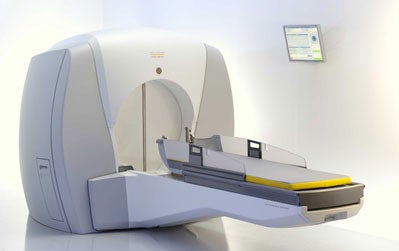Pituitary Tumor Program
UVA endocrinologists led the development of all existing medical treatments for pituitary tumors and the refinement of replacement therapy for pituitary deficiency. Our pituitary program sees several hundred new patients and performs 100+ surgeries each year. Patients can be seen in clinic one day and scheduled for surgery the following day. A visit to our clinic includes consultations with endocrinology, neurosurgery and Gamma Knife physicians who will discuss the full range of treatment options in a single visit.
Teamwork
UVA neurosurgeons have pioneered techniques for removing pituitary tumors, including the development of transsphenoidal and endoscopic approaches to the pituitary region. Our interdisciplinary team of top neurosurgeons, endocrinologists, neuro-ophthalmologists, neuro-oncologists, nurses and therapists, include:
- Michael Catalino, M.D. (Neurosurgeon)
- Melike Mut Askun, MD,PhD (Neurosurgeon)
- Mary Lee Vance, M.D. (Endocrinologist)
- Gregory Hong, M.D. (Endocrinologist)
- Jason Sheehan, MD,PhD (Gamma Knife Neurosurgeon)
- Maria-Beatriz Lopes, M.D. (Neuropathologist)
- Spencer C. Payne, M.D. (Otolaryngology – Head and Neck Surgeon)
- Jose Mattos, M.D. (Otolaryngology – Head and Neck Surgeon)
Because of the sheer volume of pituitary cases they see each year, our specialists have the experience and expertise necessary to make accurate diagnoses. And since such a diverse range of physicians weigh in on each case, you can be certain that they will map out the most effective treatment option for each patient.
The goals of the team are to provide relief from the effects of the tumor mass, normalize hormonal hypersecretion, restore normal pituitary function and prevent recurrence of tumor growth.
Diagnosis
Together, this group works to diagnose and develop treatment plans for pituitary patients. Diagnostic methods include CT scans, MRI, hormone analysis, provocative testing, inferior petrosal sinus sampling (IPSS) and neuropathology. Neuropathologists analyze tumors for more than seven hormones and other markers, and use electron microscopy to further subtype adenomas. This thorough analysis ensures that our neurosurgeons and endocrinologists can accurately prescribe detailed, comprehensive treatment plans and appropriate follow-up therapies.
- Prolactinoma
- Acromegaly
- Cushing’s Disease
- TSH Secreting Tumor
- Non Secretory Tumor
- Craniopharyngioma/Rathke’s Cleft Cyst
- Pituitary Cyst
Treatment
Surgical techniques employed by our department include transsphenoidal microsurgery, endoscopic surgery, extended transsphenoidal skull-base approaches and craniotomy, when indicated. Transsphenoidal surgery is generally considered a first-line treatment for most symptomatic pituitary tumors, because it can provide prompt relief from excess hormone secretion and it allows for decompression of adjacent neural structures. Physicians at UVa have conducted thousands of transsphenoidal pituitary operations and continue to lead the field in expertise in this area.
Dr. Jane Jr. is one of the foremost users of the endoscope for the removal of pituitary adenomas, craniopharyngiomas, skull-base meningiomas, and chordomas. Use of the endoscope should allow patients to breathe through their noses postoperatively and significantly reduce the amount of postoperative pain.
 Radiotherapy and gamma knife radiosurgery, as well as medical therapy, are also options considered by our team for each pituitary case. Once a first-line treatment, radiotherapy is currently used more often to treat postoperativeresidual tumor and to prevent recurrence. And, though medical therapy is effective for certain hypersecretory pituitary tumors, it is suppressive in nature, which means that most tumors recur once medical treatment is discontinued. However, UVa’s team always considers all treatment options – surgery, medicine and radiotherapy – and maps out the safest and most effective plan for each patient.
Radiotherapy and gamma knife radiosurgery, as well as medical therapy, are also options considered by our team for each pituitary case. Once a first-line treatment, radiotherapy is currently used more often to treat postoperativeresidual tumor and to prevent recurrence. And, though medical therapy is effective for certain hypersecretory pituitary tumors, it is suppressive in nature, which means that most tumors recur once medical treatment is discontinued. However, UVa’s team always considers all treatment options – surgery, medicine and radiotherapy – and maps out the safest and most effective plan for each patient.
Outcomes
With the substantial volume of pituitary cases treated at UVa comes an excellent history of results for transsphenoidal operations. Remission of symptoms of microadenomas is generally in the 87-91 percent range, and is in the 56-90 percent range for macroadenomas. For both micro- and macroadenoma patients, anywhere from 75-90 percent – depending on the type of tumor – are living and doing well without evidence of further pituitary disease after 10 years. Mortality rates are less than 0.5 percent, major complications are less than 1.5 percent, and minor problems occur in less than 6.5 percent of cases.
Publications geared towards Physicians
Video Presentations by our Experts
- Ideal Outcome of Treatment of Cushing’s Disease: Dr. Ed Oldfield
- What to Expect During Recovery, Tapering and Follow-up: Dr. Mary Lee Vance
- Options for Treatment of Unsuccessful Pituitary Surgery and Recurrent Cushing’s: Dr. Ed Oldfield
- Cushing’s and Quality of Life: Dr. Mary Lee Vance
Facilities
UVA’s Neuro-endocrine facilities consist of:
- several beds specially equipped for patients undergoing pituitary procedures – the Inpatient Neuro-endocrine Unit.
- a modern fully equipped outpatient Pituitary Clinic with capacity for on-site sophisticated endocrine testing with prompt results, same-day neuro-imaging support (MRI), and a multidisciplinary focus with simultaneous Endocrinology/Neurosurgery consultation, prompt evaluation from Neuro-ophthalmology (visual testing) and Gamma Knife Radiosurgery.
- state of the art “smart” operating rooms fully equipped with microscopes, endoscopes, laser, and computer-guided neuro-navigation.
- a clinic research center and research labs offering clinical trials that can directly benefit patients.
- Radiology – MRI, CT, angiography, IPS sampling.
- Neuropathogy – histology, immunocytochemistry, electron microscopy, tissue bank.
Clinical Trials and Research
As an academic medical center, UVA is a center for ongoing basic and clinical research, as well as clinical trials of novel and innovative therapies.
Contact
Phone: 434-982-3591
Toll-free: 800-650-2650
Fax: 434-924-5894
